Ultimate Limestone Floor Restoration Services: Preserve Your Investment
-
- Limestone is a porous, acid-sensitive stone that necessitates professional care to sustain its beauty and structural integrity over time.
- Common challenges include dullness, etching, staining, grout erosion, and lippage, often caused by foot traffic, accidental spills, and improper cleaning techniques.
- DIY cleaning attempts can worsen damage, particularly when using acidic or abrasive products unsuitable for limestone.
- Professional restoration services encompass inspection, extensive cleaning, diamond honing, regrouting, and sealing: all customized to the stone’s specific condition and environment.
- Sealants should be breathable and UV-stable, selected based on the room’s specific use (e.g., kitchens, bathrooms, historic interiors).
- Case studies from London properties demonstrate successful restorations in kitchens, hallways, and bathrooms achieved through professional techniques.
- Post-restoration maintenance requires pH-neutral cleaning, sealant reappliance, and avoiding steam or harsh chemicals to preserve the finish.
- London Stone services Central, North, South, East, and Greater London, catering to both historic homes and commercial properties.
Understanding the Importance of Limestone Restoration Services
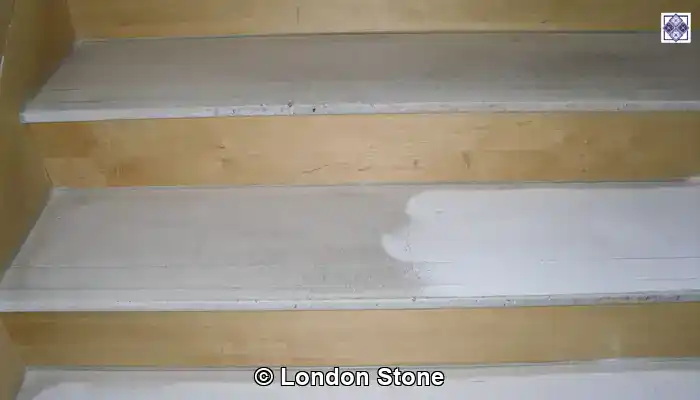
Limestone flooring adds an air of timeless elegance to both residential and commercial spaces throughout London. Its soft, natural colors and intricate veining make it a favored choice for hallways, kitchens, bathrooms, and even heritage properties. However, while limestone is undeniably beautiful, it is also one of the more delicate natural stones, requiring specialized care to maintain its appearance and structural integrity over time. Without proper care, this stunning flooring can quickly lose its charm, making professional restoration services essential for preserving its beauty.
Expert Recommendations for Daily Cleaning Products to Maintain Limestone Floors
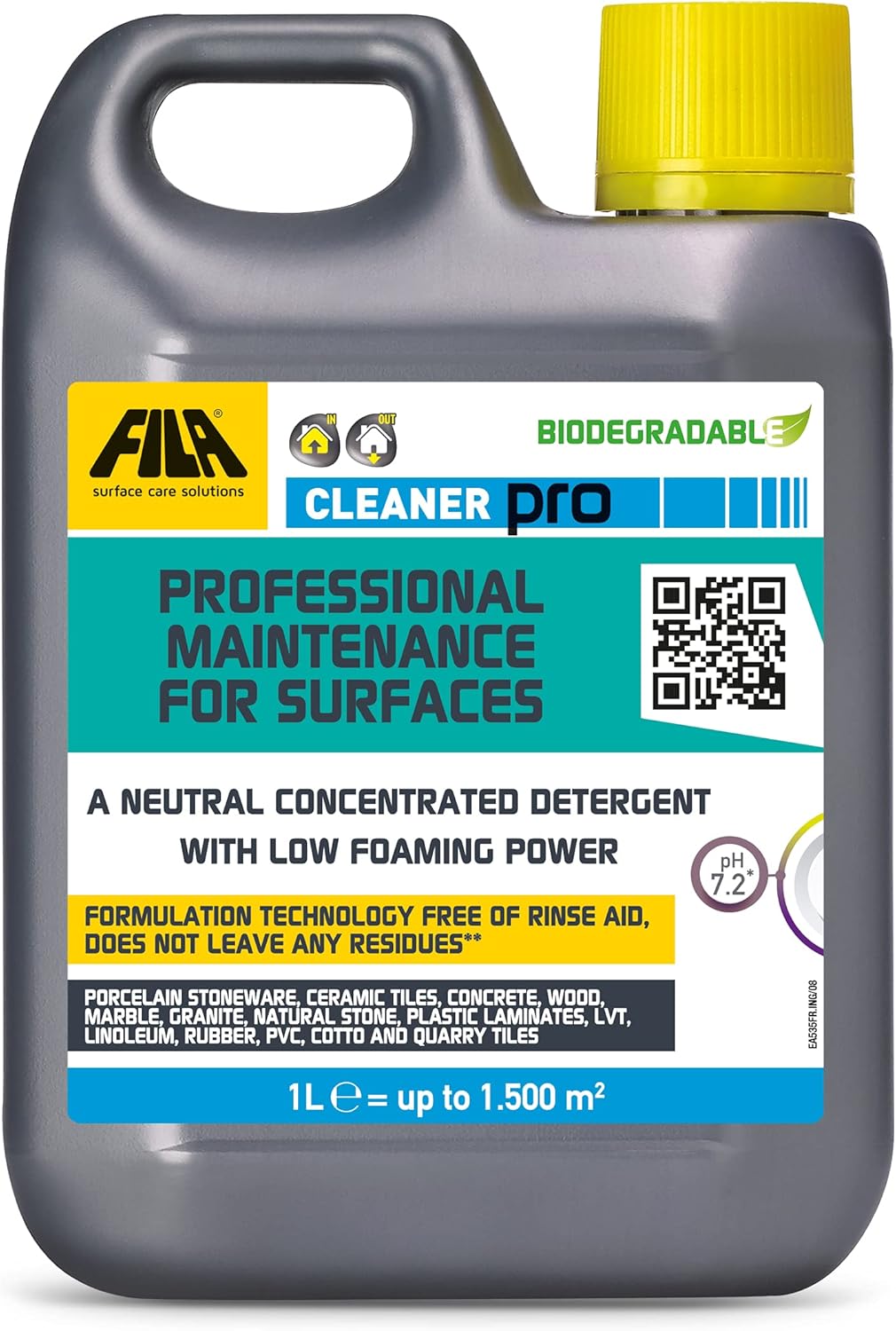
Fila Pro Floor Cleaner
|
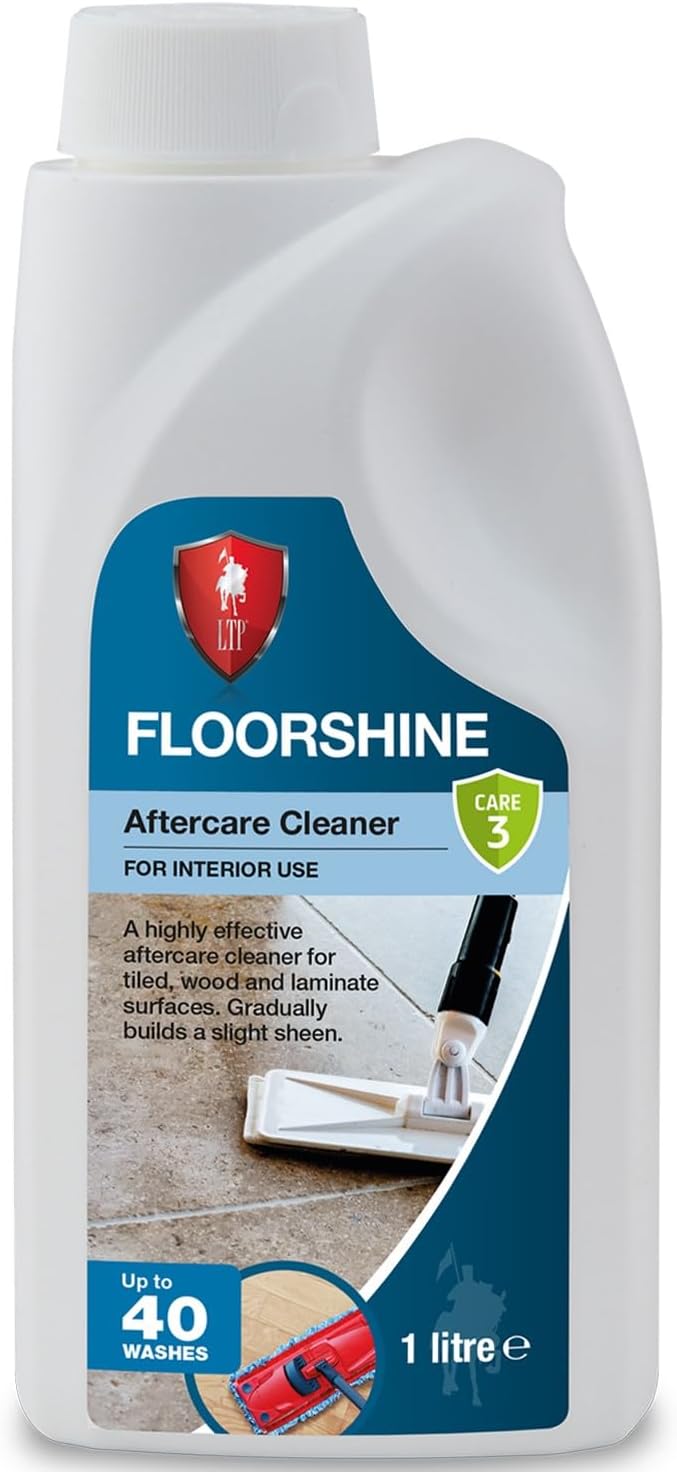
LTP Floorshine
|
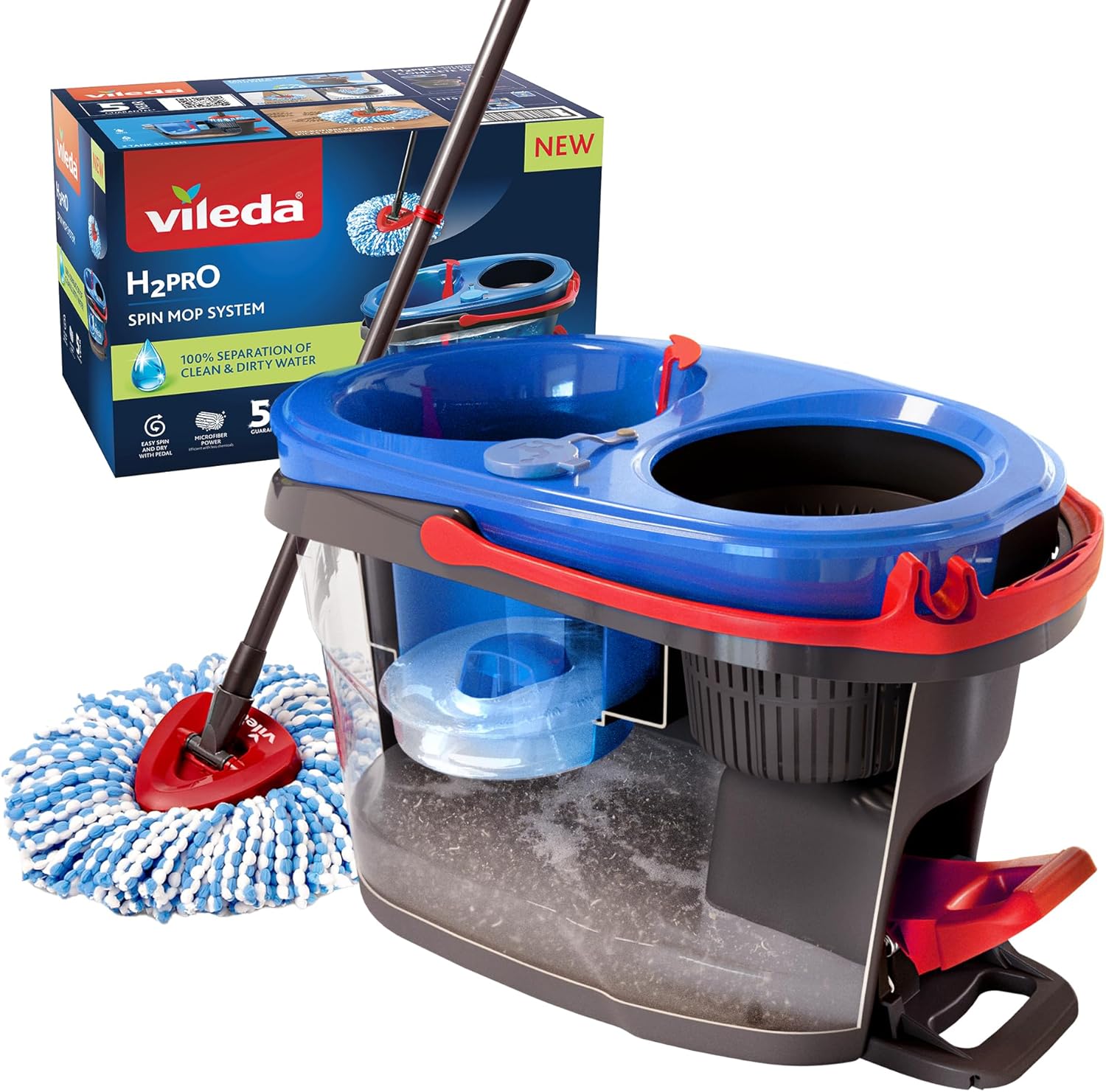
Vileda H2PrO Spin Mop System
|
Exploring the Unique Characteristics of Limestone as a Natural Stone Surface
Unlike granite or porcelain, limestone is a sedimentary rock formed over millions of years from compressed marine materials and organic minerals. Its unique composition renders it relatively porous and sensitive to acidic substances, which can lead to the absorption of moisture, cleaning agents, and spills. This vulnerability can result in common issues such as staining, etching, and surface erosion, particularly in areas with high foot traffic and frequent cleaning routines. Understanding these characteristics is essential for effective maintenance and restoration of limestone flooring.
Identifying Common Limestone Floor Issues in London Homes
Homeowners frequently notice their limestone floors losing their natural shine, developing uneven patches, or exhibiting signs of pitting and grout deterioration. These concerns extend beyond mere aesthetic appeal; when sealants deteriorate or grout erodes, moisture may infiltrate both the stone and the underlying subfloor, leading to severe structural complications. In heritage buildings, this can jeopardize original flooring and necessitate costly repairs. Therefore, recognizing these issues early can save homeowners both time and money in the long run.
How DIY Cleaning Attempts Often Worsen Limestone Floor Damage
Generic stone cleaning products and off-the-shelf sealants may appear convenient, yet they frequently fail to effectively cater to limestone. Acidic or alkaline substances can etch the surface, leaving dull patches or streaks. Inadequate sealing can trap moisture or fail to bond with the stone’s porous structure. Without the correct tools and expertise, DIY efforts often lead to greater damage—especially when dealing with delicate finishes or uneven tile arrangements. This underscores the importance of professional intervention for limestone care.
Why Professional Stone Restoration Services are Indispensable
Professional limestone restoration extends beyond mere surface cleaning. It commences with a detailed inspection to identify the root causes of damage—whether arising from improper sealing, acidic spills, or wear due to foot traffic. Restoration specialists utilize pH-neutral cleaning solutions that effectively eliminate ingrained dirt without harming the stone, followed by diamond honing to smooth scratches and restore a consistent finish. Grout lines are either repaired or replaced, and breathable, UV-stable sealants are applied to safeguard the stone from future deterioration, ensuring longevity and beauty.
Safeguarding Heritage Flooring with Expert Restoration
Whether your limestone flooring is situated in a modern townhouse or a heritage-listed property, restoration represents an investment in both aesthetic appeal and lasting durability. With appropriate care, limestone can endure for decades—providing a warm, natural surface that enhances any environment. However, maintaining its integrity requires more than just a mop and bucket. Specialized restoration ensures that your floor not only looks its best but also functions optimally year after year.
Diving Deep into the World of Limestone Flooring
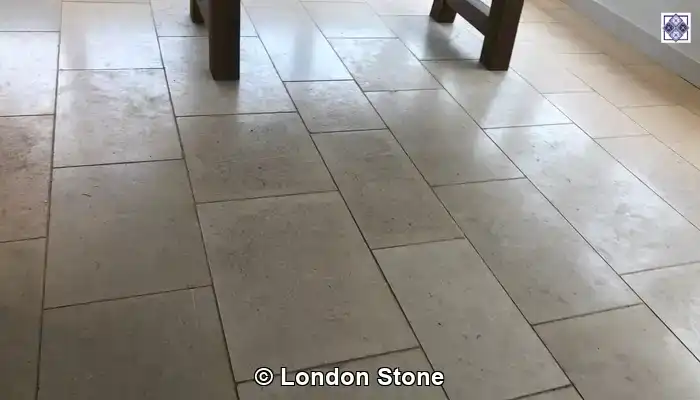
Limestone ranks among the most commonly used natural stones in UK homes, valued for its warm hues, subtle textures, and versatility in complementing both modern and traditional interiors. Yet, beneath its sophisticated appearance lies a material that is surprisingly sensitive—and this sensitivity is precisely why restoration must be performed with the utmost care to preserve its beauty and functionality.
Defining Limestone: A Distinct Sedimentary Stone
Limestone is a sedimentary rock formed over millions of years from compacted marine organisms and minerals. Its composition mainly consists of calcium carbonate, which provides a soft, chalky texture and inherent porosity. This porosity is what makes limestone highly receptive to polishing and sealing; however, it also renders it vulnerable to staining, etching, and moisture damage. Homeowners must be aware of these traits to ensure proper care and maintenance.
Unlike granite or quartzite, limestone does not possess resistance to acids. Even mild acidic substances, such as lemon juice, vinegar, or certain household cleaning agents, can react adversely with the surface, resulting in dull spots known as etching. This is particularly common in kitchens and bathrooms, where spills and cleaning routines occur frequently. Understanding these risks is crucial for maintaining the beauty of limestone surfaces.
Why Tailored Restoration Techniques are Essential for Limestone
Due to its softness and absorbency, limestone cannot be treated in the same manner as harder stones. Restoration necessitates a careful balance of cleaning, honing, and sealing—each step customized to the stone’s specific condition and surroundings. For instance, a hallway floor subjected to muddy boots and continuous foot traffic will require more intensive cleaning and a more robust sealant than a lightly used guest bathroom. Tailoring the approach ensures the best results for each unique surface.
Professional restoration begins with evaluating the stone’s finish—whether it’s honed, polished, or tumbled—followed by assessing the degree of wear. Subsequently, specialists utilize pH-neutral cleaners to eliminate embedded dirt without damaging the surface, coupled with diamond abrasives to smooth out scratches and restore uniformity. The final step involves sealing, which protects the stone from future damage while allowing it to breathe, ensuring longevity and aesthetic appeal.
Comparing Limestone to Other Natural Stones: Its Unique Attributes Explained
When compared to marble, limestone is less dense and more prone to surface erosion. Against travertine, it has a finer grain and fewer natural voids, yet still requires regular sealing to maintain its appearance. These differences imply that restoration techniques must be tailored—not merely replicated from one stone type to another. Homeowners often assume that all stone floors can be treated uniformly; however, applying a marble polish on limestone or using a generic sealant can lead to streaking, residue buildup, or even long-term damage. This reinforces the importance of collaborating with a specialist who understands limestone’s unique properties.
Recognizing Signs That Your Limestone Floor Needs Restoration
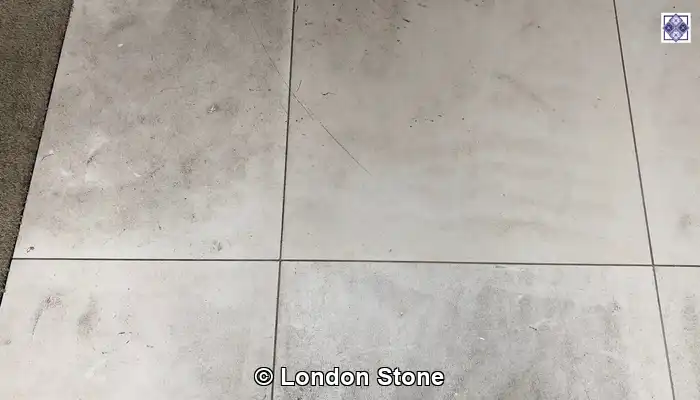
While limestone can be durable, it is far from impervious to wear and tear—especially in busy London homes where foot traffic, spills, and cleaning routines exert considerable influence. Recognizing the early warning signs of damage is crucial to preventing long-term deterioration and avoiding costly repairs. Addressing issues promptly can significantly extend the life of your limestone flooring.
Recognizing Surface Dullness and Loss of Natural Shine
One of the first indications that your limestone floor requires attention is a noticeable reduction in its natural shine. Over time, micro-abrasions from dirt, shoes, and cleaning tools can wear down the surface, rendering it flat and lifeless. This dullness is especially prevalent in hallways, kitchens, and other high-traffic areas. Professional polishing can revive the original finish, but it is vital to act before deeper damage occurs. If the floor no longer reflects light uniformly or feels rough to the touch, this is a clear indication that restoration is necessary.
Identifying Etching and Staining from Everyday Use
Limestone’s calcium-rich structure makes it exceptionally sensitive to acids. Even gentle substances like lemon juice, wine, or vinegar can result in etching—those pale, chalky marks that seem to appear spontaneously. Likewise, spills that are not promptly addressed can seep into the stone, causing stubborn stains. These imperfections are not merely superficial; they often indicate that the sealant has deteriorated, exposing the stone to further damage. Restoration involves not only cleaning and polishing but also reapplying a protective sealant that corresponds to the room’s specific conditions.
Recognizing Grout Erosion and Discoloration Issues
Grout lines play a significant role in the stability and aesthetic appeal of your limestone floor. When grout begins to crack, crumble, or change color, it can facilitate moisture penetration beneath the tiles—compromising adhesion and encouraging mold growth. In older installations, grout may have been improperly applied or with the wrong formulation. Restoration includes removing compromised grout and replacing it with a color-matched, durable blend that complements the stone and effectively seals the joints. This step is essential for maintaining the integrity of the entire flooring system.
Addressing Uneven Tiles and Lippage Concerns
Lippage refers to the height discrepancy between adjacent tiles, representing more than just an aesthetic flaw—it can pose a tripping hazard. Over time, subfloor movement or improper installation can lead to tile displacement, creating sharp edges or uneven surfaces. Professional restoration addresses lippage through careful grinding and leveling, ensuring a smooth, safe walking surface. This is particularly crucial in homes with children, elderly residents, or areas where bare feet are customary, such as bathrooms. Ensuring safety and beauty in these spaces is paramount.
Dealing with Embedded Dirt That Resists Conventional Cleaning Methods
If your limestone floor appears dirty even after mopping, the issue may extend beyond surface grime. The porous nature of the stone, combined with worn sealants, allows dirt to settle into microscopic pits and grout lines, making it nearly impossible to clean effectively with standard methods. Specialist restoration employs pH-neutral cleaners along with mechanical agitation to extract embedded soils without causing harm to the stone. The result is a visibly cleaner, healthier floor that is easier to maintain moving forward, ensuring longevity and aesthetic appeal.
Unveiling Our Comprehensive Limestone Restoration Process
Restoring a limestone floor is not merely about enhancing its appearance; it’s also about preserving the stone’s integrity and ensuring optimal performance over the long term. At London Stone, our restoration process is meticulously designed to address both surface-level issues and underlying structural concerns, utilizing specialized tools and techniques tailored to each floor’s condition. This thorough approach ensures that every aspect of your limestone flooring receives the attention it deserves.
Conducting a Thorough Initial Inspection and Stone Assessment
Every restoration project commences with a comprehensive inspection. We evaluate the type of limestone, its finish (honed, polished, tumbled), and the extent of wear or damage. This includes checking for etching, staining, lippage, grout erosion, and the condition of the sealant. Understanding the stone’s history and environment—whether it’s a busy hallway, a damp bathroom, or a heritage-listed space—guides us in determining the most effective approach. This initial analysis is crucial for devising a tailored restoration plan.
Conducting In-Depth Cleaning with pH-Neutral Solutions
Limestone’s porous surface tends to trap dirt and cleaning residues over time, especially when sealants have weakened. We utilize pH-neutral cleaners specifically formulated for natural stone to remove embedded soils without harming the surface. Mechanical agitation tools assist in dislodging grime from grout lines and microscopic pits, restoring a clean, uniform base for subsequent treatment. This step is vital for achieving optimal results in the restoration process.
Implementing Diamond Honing and Surface Refinement Techniques
Once the floor is thoroughly cleaned, we begin the honing process using diamond abrasives. This stage smooths out scratches, etching, and uneven patches, restoring the stone’s natural texture and preparing it for polishing. Depending on the desired finish—whether matte, satin, or high-gloss—we adjust the grit level and technique to achieve consistent results across the entire surface. This attention to detail ensures that the final outcome meets the homeowner’s expectations.
Conducting Grout Repair and Regrouting Procedures
Damaged or discolored grout is carefully removed using precision tools that protect the surrounding stone. We then apply a color-matched grout blend that complements the limestone and effectively seals the joints. In high-traffic areas, we may recommend epoxy grout for enhanced durability and stain resistance. Proper grout restoration is crucial for maintaining the overall integrity of the floor.
Choosing Sealants and Ensuring Professional Application
The final stage involves sealing. We employ breathable, UV-stable sealants that protect the stone from moisture, staining, and surface erosion while allowing it to release trapped vapors. Sealants are selected based on the specific conditions of the room—kitchens may require oil-resistant formulas, while sunlit areas benefit from UV protection. The application is executed evenly and professionally to ensure complete coverage without streaks or residue, providing long-lasting protection for your limestone floor.
Final Inspection and Customized Maintenance Guidance
Upon completion of restoration, we conduct a final walkthrough with the client to ensure satisfaction and provide tailored maintenance advice. This includes recommendations for daily cleaning, sealant reapplication, and periodic inspections to keep the floor looking its best. Providing this ongoing support is essential for maintaining the beauty and functionality of your limestone flooring.
Why Choose London Stone for Exceptional Limestone Restoration Services?
When it comes to restoring limestone floors, experience and precision are essential. At London Stone, we combine specialized knowledge with hands-on expertise to deliver results that exceed surface-level improvements. Our approach is customized, transparent, and grounded in years of experience with natural stone in residential properties, heritage buildings, and commercial environments throughout London. This dedication to excellence sets us apart in the industry.
Proven Expertise in Natural Stone Restoration
Limestone is not a uniform material. Its porosity, mineral composition, and finish vary greatly depending on its origin and installation. Our team understands these nuances and employs restoration techniques tailored to each floor’s unique requirements. From diamond honing to epoxy regrouting, every step is executed with precision and meticulous care. We have successfully restored limestone floors in Georgian townhouses, modern lofts, and heritage buildings—each presenting its own challenges. Our portfolio encompasses high-end interiors, underfloor heating systems, and intricate tile layouts, equipping us with the experience to manage even the most demanding projects.
Utilization of Professional Tools and Stone-Safe Products
We utilize professional-grade equipment and stone-safe products that are not available in DIY kits or standard cleaning services. Our pH-neutral cleaners, breathable sealants, and dust-free grinding systems are specifically chosen to protect your limestone while delivering a flawless finish. Whether your floor requires a satin sheen or a high-gloss polish, we customize the treatment to align with your aesthetic preferences and the stone’s condition. We also provide sealants featuring UV protection, oil resistance, and anti-slip properties—ideal for kitchens, bathrooms, and sunlit areas.
Transparent Service with Tailored Solutions
At London Stone, we believe in straightforward communication and honest pricing. Every restoration project begins with a detailed consultation and a written quote outlining the scope of work and anticipated outcomes. We avoid upselling unnecessary treatments or compromising on quality. Our services are customized to your space, usage patterns, and long-term objectives. Whether you require a one-off restoration or ongoing maintenance support, we will formulate a plan that aligns with your needs and budget.
Recognized by Homeowners and Property Managers Across London
Our reputation is built on trust, craftsmanship, and tangible results. Clients consistently commend our professionalism, meticulous attention to detail, and our ability to rejuvenate even the most neglected limestone floors. We take pride in being a preferred resource for homeowners, interior designers, and property managers seeking expert stone care. This recognition reflects our commitment to delivering exceptional service and results.
Real-World Case Studies: Transformations of Limestone Floors in London Homes
Witnessing the transformation of a limestone floor firsthand often inspires homeowners to invest in professional restoration. At London Stone, we have tackled a diverse array of properties—from contemporary apartments to heritage-listed structures—each presenting its own challenges and character. These case studies illustrate how tailored restoration can revitalize even the most neglected stone surfaces. They serve as a testament to the effectiveness of our specialized techniques.
Reviving a Dull and Stained Kitchen Floor in Notting Hill
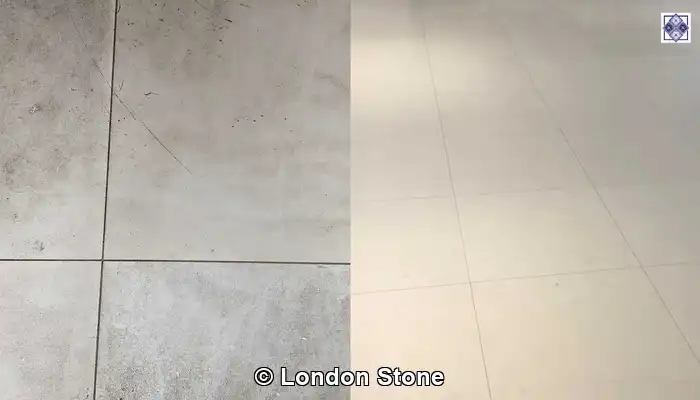
A client in Notting Hill contacted us after years of cooking spills and foot traffic had rendered their limestone kitchen floor dull, stained, and uneven. The original sealant had worn away, allowing oils and acidic substances to permeate the stone. Grout lines were discolored, and several tiles exhibited surface etching. We began with a deep cleaning using pH-neutral solutions to extract entrenched grease and grime. Diamond honing removed the etched areas and restored a smooth, consistent finish. We then regrouted with a color-matched blend and applied a breathable, oil-resistant sealant tailored for kitchen environments. The result was a brighter, more hygienic floor that looked brand new—and was significantly easier to maintain.
Leveling and Regrouting in a Victorian Townhouse
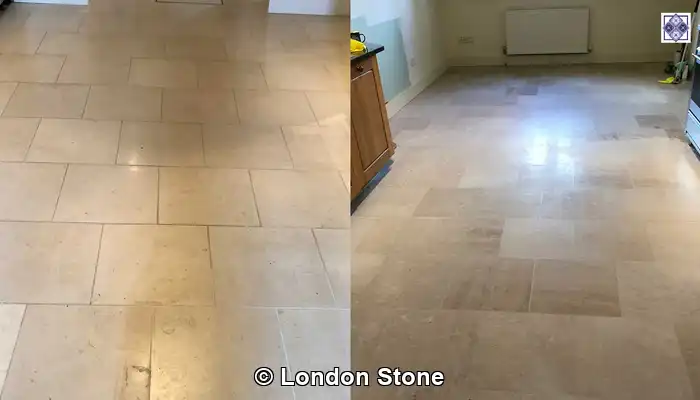
In a Victorian townhouse located in Kensington, the limestone kitchen had developed significant lippage due to subfloor movement over time. The uneven tiles not only appeared unsightly but also posed a tripping hazard. Grout had eroded in several areas, and the surface had lost its original polish. Our team utilized precision grinding tools to level the tiles and eliminate sharp transitions. We removed the old grout and replaced it with a durable epoxy blend, flush with the tile surface for a seamless finish. After polishing and sealing, the kitchen transformed into a safe, elegant entryway that honored the home’s period features.
Restoring a Kitchen Floor in a Heritage Property
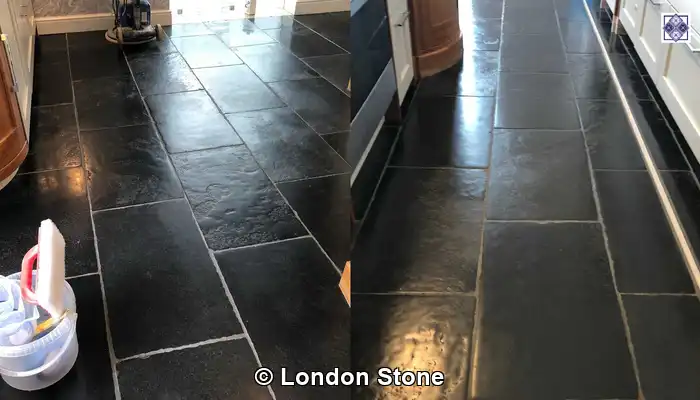
A heritage-listed property in Hampstead posed a unique challenge: a limestone bathroom floor that had been inadequately sealed, resulting in moisture ingress and mold growth in the grout. The client was concerned about preserving the original stone while ensuring the space remained safe and functional. We meticulously removed the failing sealant and treated the stone with a mold-safe, pH-balanced cleaner. After regrouting and polishing, we applied a breathable sealant designed for humid environments. The floor retained its historic charm while gaining modern protection against moisture and wear. These case studies exemplify our commitment to craftsmanship, safety, and customized solutions. Whether it’s a bustling family kitchen or a listed building with delicate stonework, London Stone delivers restoration that respects both the material and the inhabitants who live with it.
Essential Maintenance Tips Post-Limestone Restoration
Professional restoration can significantly enhance the appearance and longevity of your limestone floor—but maintaining its condition requires consistent, informed care. By adopting appropriate daily habits and periodic upkeep, homeowners can safeguard their investment and enjoy a beautifully maintained surface for many years. These maintenance tips are designed to help you enjoy the benefits of your investment.
Daily Cleaning with pH-Neutral Products for Longevity
Limestone’s sensitivity to acidic and alkaline substances makes it essential to use a pH-neutral cleaner specifically formulated for natural stone. Avoid using supermarket floor cleaners, bleach, vinegar, or citrus-based products, as they can etch the surface and degrade sealants. For optimal results, utilize a microfiber flat mop or spin mop that is dampened—not soaked—with your selected cleaner. Excess water can penetrate grout lines and beneath tiles, especially if sealants have begun to wear. Damp cleaning effectively lifts dust and grime without saturating the stone, ensuring its longevity.
Avoiding Common Mistakes in Limestone Cleaning
Steam cleaners, abrasive pads, and harsh chemicals may seem practical, but they can cause long-term damage to limestone. Steam can weaken grout and force moisture into the stone, while abrasives scratch the surface and dull the finish. Instead, opt for soft tools and gentle methods. If uncertain about a product, test it on a small, inconspicuous area or consult your restoration specialist for advice. This precaution helps prevent unintended damage to your beautiful flooring.
Reapplying Sealant in High-Wear Areas for Protection
Even top-quality sealants diminish over time—especially in kitchens, hallways, and bathrooms. To maintain protection against stains and moisture, consider reapplying your sealant every 12–18 months in these areas. A breathable, UV-stable sealant that matches your stone type and room conditions will yield the best results. If you notice that water no longer beads on the surface or stains are becoming increasingly difficult to remove, it’s likely time for resealing. This proactive measure is crucial for preserving your investment.
Grout Maintenance and Spot Repairs to Ensure Integrity
Grout lines are often the first to show signs of wear and tear. Keep an eye out for cracking, discoloration, or gaps between tiles, as these can allow moisture ingress and lead to tile movement or mold growth. Spot repairs can be performed using color-matched grout or epoxy blends, but deeper erosion may necessitate professional regrouting. Regular inspections help identify issues early before they escalate, ensuring the longevity and functionality of your flooring.
Scheduling Regular Professional Inspections for Longevity
Even with diligent care, limestone floors benefit from periodic professional evaluations. A restoration specialist can assess the state of your sealant, grout, and surface finish, recommending touch-ups or preventive treatments as necessary. For busy households or heritage properties, an annual inspection ensures that your floor remains safe, attractive, and structurally sound. This regular maintenance is essential for protecting your investment over time.
Common Questions About Limestone Floor Restoration Answered
Opting to restore your limestone floor is a wise investment—but it’s natural to have questions before proceeding. Below are answers to some of the most commonly asked inquiries we receive from homeowners throughout London, providing clarity on the restoration process.
How long does the limestone restoration process typically take?
The duration of restoration depends on the size of the area, the extent of damage, and the specific treatments needed. A typical residential room may require 1–2 days, whereas larger or more complex projects—such as heritage properties or floors with significant lippage—might necessitate additional time. We always provide a clear timeline during your initial consultation to ensure transparency.
Is limestone restoration safe for heritage properties?
Absolutely. Our techniques are crafted to be non-invasive and conservation-friendly, making them suitable for listed buildings and historic interiors. We utilize dust-free equipment, breathable sealants, and gentle cleaning agents that preserve the stone’s integrity while enhancing its appearance. This commitment to safety and preservation is a core aspect of our service.
Can deep etching or scratches be effectively removed from limestone surfaces?
In most cases, yes. Diamond honing is highly effective at eliminating surface-level etching, scratches, and dull patches. For more severe damage, we assess whether grinding or tile replacement is necessary. Our aim is always to restore the stone while preserving as much of the original material as possible, ensuring a seamless finish.
What distinguishes polishing from sealing in the restoration process?
Polishing enhances the stone’s appearance by smoothing the surface and restoring its natural shine. Sealing, in contrast, protects the stone from moisture, stains, and erosion. Both processes are essential components of a comprehensive restoration and are customized based on the stone’s finish and room conditions. Understanding the difference helps homeowners appreciate the value of each process.
Will the restoration process create dust or mess in my home?
No. We utilize dust-controlled equipment and protective barriers to maintain cleanliness within your home throughout the restoration process. Floors are vacuumed and wiped down after each stage, ensuring minimal disruption to your daily activities. Our goal is to provide a seamless experience for our clients.
How frequently should limestone be resealed for optimal protection?
We recommend resealing every 12–18 months in high-traffic or moisture-prone areas such as kitchens, hallways, and bathrooms. Low-traffic zones may require less frequent attention. During restoration, we will advise you on the optimal sealant and maintenance schedule for your specific floor, ensuring continued protection.
Can I walk on my limestone floor immediately after restoration?
In most cases, you can walk on the floor within 4–6 hours after sealing; however, we recommend waiting 24 hours before placing furniture or rugs. We will provide clear aftercare instructions to ensure the sealant cures properly and that the finish remains intact, protecting your investment.
Areas We Proudly Serve Across Greater London
At London Stone, we proudly offer professional limestone floor restoration services throughout Greater London and its surrounding boroughs. Whether you live in a city flat, a suburban townhouse, or a heritage-listed property, our team is equipped to provide expert care wherever it is needed. Our service area covers a wide range of locations, ensuring that homeowners can access our specialized expertise.
Central London and Historic Districts: Our Expertise in Preservation
We frequently operate in Central London neighborhoods such as Kensington, Chelsea, Westminster, and Mayfair—areas renowned for their elegant limestone interiors and period architecture. Our restoration techniques are tailored to meet the conservation standards required in listed buildings and historic residences. We understand the unique challenges presented by these properties and take pride in preserving their character.
North and West London Residences: Customized Solutions for Diverse Homes
From Hampstead and Highgate to Ealing and Chiswick, we cater to a diverse range of residential clients in North and West London. These areas often feature limestone in hallways, kitchens, and bathrooms, where foot traffic and moisture exposure necessitate specialized attention. Our tailored services ensure that every restoration project meets the unique needs of each home.
South and East London Properties: Adapting Techniques to Fit Each Environment
We also restore limestone floors in South London boroughs like Clapham, Dulwich, and Wimbledon, as well as East London locations including Hackney, Shoreditch, and Canary Wharf. Whether it’s a modern loft or a Victorian terrace, our team adapts restoration methods to suit the property’s age, layout, and usage. This flexibility allows us to effectively address the specific challenges each property presents.
Greater London and Surrounding Counties: Extending Our Expertise Beyond the City
In addition to London postcodes, we extend our services to nearby counties such as Surrey, Hertfordshire, and Essex. Clients in commuter towns and rural homes benefit from the same high standards of care, with flexible scheduling and customized service plans that meet their unique needs. Our commitment to quality ensures that every client receives the best possible service.
Commercial and Heritage Sites: Ensuring Excellence in Every Project
Beyond residential projects, we also support commercial clients and heritage institutions. Our portfolio includes boutique hotels, galleries, retail spaces, and historic buildings, where limestone flooring plays a vital role in the interior design. We recognize the need for minimal disruption and enduring results in these environments, ensuring that our services meet the highest standards of quality and professionalism.
Whether you’re restoring a single room or an entire property, London Stone offers reliable, local expertise backed by years of hands-on experience. Our dedication to excellence and customer satisfaction is evident in every project we undertake.
Schedule Your Professional Limestone Floor Restoration Today
Your limestone floor deserves expert care—and London Stone is here to provide it. Whether you’re faced with dullness, staining, grout erosion, or uneven tiles, our specialized restoration services are designed to rejuvenate your floor’s natural beauty and protect it for years to come. Investing in professional restoration ensures long-lasting results and a stunning appearance.
Arrange a Complimentary Consultation for Tailored Solutions
We offer no-obligation consultations throughout London and the surrounding areas. During your visit, we will assess your floor’s condition, explain the available restoration options, and provide a transparent quote tailored to your space and requirements. You will receive expert guidance, honest recommendations, and a clear action plan designed to meet your specific needs.
To initiate the process, use our simple contact form or call our team directly. We are pleased to address any questions and arrange a convenient time to visit your property. Your satisfaction is our priority, and we look forward to restoring your limestone flooring.
Endorsed by London Homeowners and Property Managers for Quality Service
London Stone has established a reputation for precision, professionalism, and lasting results. Our clientele includes homeowners, interior designers, estate managers, and heritage property custodians who rely on us to restore and maintain their natural stone surfaces. This trust reflects our commitment to delivering exceptional service and results tailored to each client’s needs.
We approach every project with care—whether it involves a single bathroom floor or an entire townhouse. Our goal is to ensure your limestone looks and feels its best while being safeguarded against future wear. This comprehensive approach to care ensures that your investment is protected.
Stay Updated with Expert Stone Care Tips
Want to maintain your limestone floor’s flawless appearance between restorations? Subscribe to our newsletter for expert maintenance tips, seasonal care advice, and exclusive offers. You can also follow us on social media for real-time updates and behind-the-scenes restoration stories. Engaging with our community allows you to stay informed and make the most of your investment.
The Article Limestone Floor Restoration Services Explained Simply appeared first on https://fabritec.org
The Article Limestone Floor Restoration Services: A Simple Guide Was Found On https://limitsofstrategy.com
The Article Limestone Floor Restoration Services Explained Simply First Appeared ON
: https://ad4sc.com
No responses yet